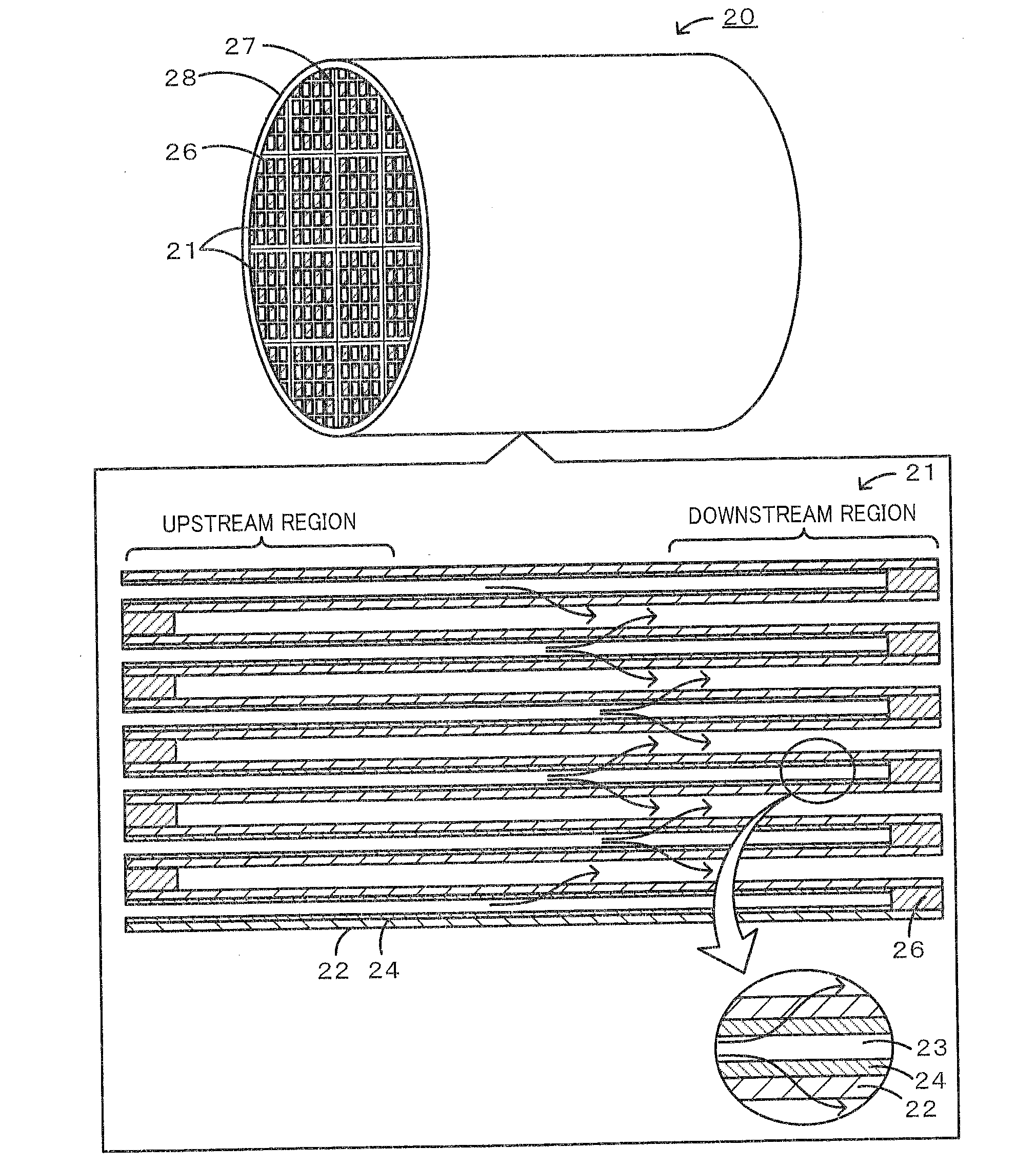Honeycomb filter
a technology of honeycomb filter and filter body, which is applied in the direction of filtration separation, separation process, transportation and packaging, etc., to achieve the effect of easy production, simplified configuration, and enhanced mechanical strength of honeycomb filter
- Summary
- Abstract
- Description
- Claims
- Application Information
AI Technical Summary
Benefits of technology
Problems solved by technology
Method used
Image
Examples
examples
[0048]Hereinafter, examples in which honeycomb filters were specifically produced will be described as experimental examples. Herein, the produced honeycomb filters had a structure in which a plurality of honeycomb segments were bonded together.
[0049]Production of Honeycomb Filter
[0050]A SiC powder and a metal Si powder were mixed at a mass ratio of 80:20. Methylcellulose, hydroxypropoxylmethylcellulose, a surfactant, and water were added to the mixture and the resultant mixture was kneaded to prepare a plastic pug. This pug was extruded with a predetermined die to form honeycomb segment formed bodies having a desired shape. Herein, the formed shape was as follows: the thickness of the partition portions was 305 μm; the cell pitch was 1.47 mm; the cross section was 35 mm×35 mm; and the length was 152 ran. The obtained honeycomb segment formed bodies were then dried with microwaves, further dried with hot air, subsequently sealed, calcined in an oxidizing atmosphere at 550° C. for 3 ...
experimental examples 1 to 7
[0057]A honeycomb filter was defined as Experimental example 1 in which the second pore volume peak position was at 14 μm and the porosity was 40% in the upstream and midstream portions of the honeycomb filter, the second pore volume peak was at 14 μm and the porosity was 40% in the downstream portion of the honeycomb filter, and the pore volume difference obtained by subtracting the volume of pores having a diameter of 10 μm or less in the upstream portion from the volume of pores having a diameter of 10 μm or less in the downstream portion (hereafter, simply referred to as pore volume difference) was 0 cm3 / g. A honeycomb filter produced as in Experimental example 1 except that the pore volume difference was made 0.01 cm3 / g was defined as Experimental example 2. A honeycomb filter produced as in Experimental example 1 except that the pore volume difference was made 0.03 cm3 / g was defined as Experimental example 3. A honeycomb filter produced as in Experimental example 1 except that...
experimental examples 8 to 14
[0059]A honeycomb filter was defined as Experimental example 8 in which, in the upstream and midstream portions of the honeycomb filter, the second pore volume peak position was at 14 μm and the porosity was 40%; in the downstream portion of the honeycomb filter, the first pore volume peak position was at 1 μm, the second pore volume peak position was at 14 μm, and the porosity was 40%; and the pore volume difference was 0.04 cm3 / g. A honeycomb filter produced as in Experimental example 8 except that the first pore volume peak position in the downstream portion was made at 2 μm was defined as Experimental example 9. A honeycomb filter produced as in Experimental example 8 except that the first pore volume peak position in the downstream portion was made at 3 μm was defined as Experimental example 10. A honeycomb filter produced as in Experimental example 8 except that the first pore volume peak position in the downstream portion was made at 5 μm was defined as Experimental example 1...
PUM
| Property | Measurement | Unit |
|---|---|---|
| diameter | aaaaa | aaaaa |
| pore diameter | aaaaa | aaaaa |
| pore diameter | aaaaa | aaaaa |
Abstract
Description
Claims
Application Information
 Login to View More
Login to View More - R&D
- Intellectual Property
- Life Sciences
- Materials
- Tech Scout
- Unparalleled Data Quality
- Higher Quality Content
- 60% Fewer Hallucinations
Browse by: Latest US Patents, China's latest patents, Technical Efficacy Thesaurus, Application Domain, Technology Topic, Popular Technical Reports.
© 2025 PatSnap. All rights reserved.Legal|Privacy policy|Modern Slavery Act Transparency Statement|Sitemap|About US| Contact US: help@patsnap.com



